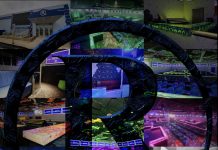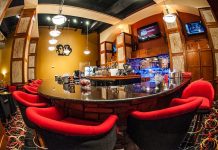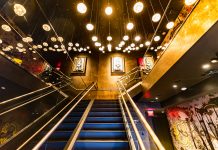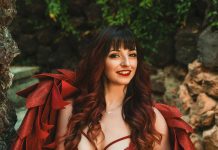“Far removed from the glossy studio work Raquel usually creates, shooting in the club forced her from her comfort zone, making images that exude the neon-lit intensity, dynamism and escapism of the club experience,” writes VICE. “Her backstage portraits anchor this high-powered fantasy world in reality, conveying the sisterhood and individuality of the strippers she got to know during the project.”
The subjects of ONYX are some of the most underrepresented artists in her hometown, shot in 2020. Captured in Raquel’s signature style, the images range in there intimacy but never in their power: displaying dance mid-movement on-stage or in the privacy of their locker room. Something Raquel has chosen artistically to exclude from the images are the male customers who frequent Onyx. Every image is from her “female gaze,” of a woman or of women.
“It was a conscious decision by the photographer, who has built a following as a Black woman photographing other women through the female gaze,” reports Creative Review.
“By focusing on the performers themselves, the series elevates the images from straight reportage to curated and highly intentional.”
“At Club Onyx, strippers step on stage displaying their bodies, strength, and seduction, but there’s a virtue to this particular space,” writes Essence content director, Nandi Howard, in the book’s introduction. “‘They don’t get naked’ is a common idiom to describe the club’s ambience. Performers there take the word ‘stripper’, and negotiate what that means to them, on their own terms.”
Originally displayed at Fotografiska New York, the photo collection now makes up the artist’s debut monograph of the same name.
Below is a replication of Adrienne Raquel’s interview with VICE:
VICE: How big a part of Houston life are strip clubs?
Adrienne Raquel: Strip culture is a staple in the South. They’re a big deal in Houston. People usually go on a Thursday, Friday or Saturday. That’s when the club is the busiest – there’ll be money falling from the ceiling. You’ll find men, of course, but a lot of women who show support for the dancers. Strip clubs here are more for the party after the party; the club usually doesn’t pop until after 2AM.
How did you pick Club ONYX?
I’ve always had a fascination with the concept of strip clubs, but it wasn’t until I actually went to ONYX that it became more than that. My aunt travelled to Houston, back in 2017, for her 50th birthday celebration. One of the places we went to was ONYX, which was very, very surprising. It was kind of spontaneous. I walked into the club with my mum, my aunt and a group of her friends. I was the youngest of the bunch. We got a section, did it properly, had some bottles and some food. We were there for about four or five hours.
It was such an interesting experience, my mum kept saying, “Oh is she OK!? Did she fall?” She was in full mom mode. There’s a taboo associated with strip clubs, of course, but beyond that it can be a bit jarring when you enter one. The atmosphere is different. The power dynamics, the sexy clothing, the music, the energy. You definitely have to get used to it all.
At that moment, I started paying attention to the women at ONYX. The way they moved about the club, how sexy and confident they were; how they commanded attention and worked together to get their money, or look after one another. There was a dynamic I observed outside of the ass shaking and money flying. I said to my mom, “One day, when I make it, I want to go back to ONYX and document the club.” And, you know, years later the opportunity came.
What was it like shooting in the club?
I’m a studio photographer. I’m accustomed to being able to control everything: lighting, energy, vibe, set design… At the strip club – what you see is what you get. All of the images that I photographed are lit from the light that was in the club. It forced me into really capturing the moment.
I like to describe myself as a bit of a wallflower, an extroverted introvert, and a little timid. The club is not a timid environment, at all. There was no being shy. If I wanted to take someone’s picture I had to tell them what I was doing, get them to sign the agreement, and step out of my own comfort zone. Some of the girls were like, “What do you want? Who are you?” you know? They were not playing any games. They were working, thinking about money.
I would arrive every night when the club was empty. The girls would be backstage in their regular clothes, eating, texting, doing their makeup. Eventually, the club is full and it’s chaos backstage: people running in and out, names being called to the stage. Some ladies are excited because they’re making hella money, some are pissed off because they haven’t made shit and they’ve been there for hours. It’s an interesting dynamic.
There’s a clear split in the book, between the glossier onstage images and the portraits made backstage.
The work is pretty much divided into two categories – you have the performance moments that are very high energy, that give the super sexy vibe, showing the money. Then you have the more intimate moments. I really wanted to show the contrast between the two.
When people think of strip clubs they think of high-powered women, money, nudity, sexuality, men, power, women being objectified. In reality, these are regular girls and performance artists within their own right. They’re trying to make sure they look pretty, they’re talking about boy problems, life problems. They might not feel like [working], they might feel down. Or maybe they’re excited. I really wanted to capture the contrast between those moments. I think the more intimate backstage photos kind of dampen the fantasy of it all. That’s the real life component.
Did you consciously decide to omit men from the images?
Not photographing men for ONYX was a huge conscious decision. I think what has really catapulted my work over the years is being a Black woman, photographing Black women through my own female gaze. I photograph women in a way that captures us in a really beautiful light. Our power, our sensuality, our softness, and our regalness.
With this project I didn’t want to include any men. ONYX is all about the ladies. I wanted to focus on them, their sisterhood, the level of camaraderie within the club. It’s a way to destigmatize stripping and sex work.
I think if I had included men it would have completely shifted the work, and I don’t think that the project would be as impactful. Then it would have just been like “Oh, photos of a strip club”, like straight reportage. It would take away from the women, and I still wanted this to feel curated, highly intentional. I want this work to relay a message.
What was the narrative, or cliché, you wanted the work to challenge?
Going back to when I first stepped foot in ONYX, I remember observing some of the body language of my aunt’s friends. I remember looking at their eyes and seeing the judgement and discomfort. It was their first time ever having this sort of experience. This all changed throughout the course of the night.
Sometimes when people hear the word “stripper” they think, “Oh, you take your clothes off for money. You’re low, or money-hungry. You have no self-worth or self-esteem, you’re broken…” But some of these ladies do it because they genuinely like the attention. Or they do it because it’s helped them build their confidence. It’s just really interesting how some of the girls challenge those assumptions.
Ten to 15 years ago my answer would be different, but sex work has become a thing. There are shows like P-Valley, movies like Zola, Hustlers… I feel like now exotic dancing is almost the cool thing to do, in a sense. During the project I got closest to eight or nine of the women, who I then focused on. These are just everyday girls. They have dreams, fears, worries. They are truly multifaceted women.
When ONYX was exhibited at Fotografiska, I received a lot of messages from people who saw the show. People told me that they took their mom or grandmother, and that they “thought it was so beautiful!” People thanked me for the project, but also for changing their families’ perspectives. I really do hope that for people who may have whatever hangups regarding exotic dancing or sex work, these images allow them to shift their perspectives.
ONYX is out now, published by Damiani.
Visit Club Onyx in Houston, TX, or online here.
For the original story and photos from Creative Review, visit here.
For the original interview from VICE and more of the photos in ONYX, visit here.





























